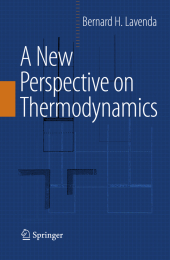 Neuerscheinungen 2014Stand: 2020-02-01 |
Schnellsuche
ISBN/Stichwort/Autor
|
Herderstraße 10
10625 Berlin
Tel.: 030 315 714 16
Fax 030 315 714 14
info@buchspektrum.de |

Bernard H. Lavenda
A New Perspective on Thermodynamics
2010. 2014. xix, 207 S. 2 Tabellen. 235 mm
Verlag/Jahr: SPRINGER, BERLIN; SPRINGER NEW YORK; SPRINGER 2014
ISBN: 1-489-98404-6 (1489984046)
Neue ISBN: 978-1-489-98404-3 (9781489984043)
Preis und Lieferzeit: Bitte klicken
This book introduces a new outlook on thermodynamics. It brings the theory up to the present time and indicates areas of further development with the union of information theory and the theory of means and their inequalities.
More than to any other single individual, thermodynamics owes its creation to Nicolas-Leonard-Sadi Carnot. Sadi, the son of the great Carnot Lazare, was he- ily in uencedby his father. Not onlywas LazareMinister of War duringNapoleon s consulate, he was a respected mathematician and engineer in his own right. Ma- ematically, Lazare can lay claim to the de nition of the cross ratio, a projective invariant of four points. Lazare was also interested in how machines operated, - phasizing the roles of work and vis viva, or living force, which was later to be associated with the kinetic energy. He arrived at a dynamical theory that machines in order to operate at maximum ef ciency should avoid any impact or sudden change. This was the heritage he left to his son Sadi. The mechanics of Newton, in his Principia, was more than a century old. It dealt with the mechanics of conservative systems in which there was no room for p- cesses involving heat and friction. Such processes would ruin the time reversibility of mechanical laws, which could no longer be derived by minimizing the difference between kinetic and potential energies. When Sadi wrote his only scienti c work in 1824, there were no laws governing the mechanical effects of heat. In fact, caloric theory was still in vogue, which treated heat as an imponderable uid that was c- served.
The Predecessors of Carnot.- Thermodynamics from Carnot to Clausius and Kelvin.- Thermodynamics in a Carnot Equation.- Equivalence of First and Second Laws.- Work from Nonequilibrium Systems.- Nonextensive Thermodynamics.
From the reviews:
"In six chapters, the author describes the fundamental principles of thermodynamics, starting from Carnot´s works and ending with nonextensive thermodynamics. ... Throughout the whole book, the author shows the power of Carnot works. He always quotes citations and computations from these original works, then considering criticisms and possible extensions. Students and researchers involved in the fundamentals of thermodynamics will surely be interested by this historical presentation of the thermodynamics starting from the pioneering works by Carnot and going to some recent extensions." (Alain Brillard, Zentralblatt MATH, Vol. 1186, 2010)


